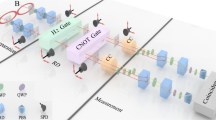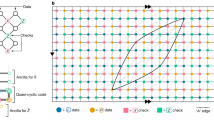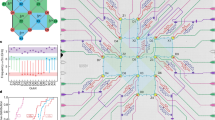Abstract
Some form of quantum error correction is necessary to produce large-scale fault-tolerant quantum computers and finds broad relevance in physics. Most studies customarily assume exact correction. However, codes that may only enable approximate quantum error correction (AQEC) could be useful and intrinsically important in many practical and physical contexts. Here we establish rigorous connections between quantum circuit complexity and AQEC capability. Our analysis covers systems with both all-to-all connectivity and geometric scenarios like lattice systems. To this end, we introduce a type of code parameter that we call subsystem variance, which is closely related to the optimal AQEC precision. For a code encoding k logical qubits in n physical qubits, we find that if the subsystem variance is below an O(k/n) threshold, then any state in the code subspace must obey certain circuit complexity lower bounds, which identify non-trivial phases of codes. This theory of AQEC provides a versatile framework for understanding quantum complexity and order in many-body quantum systems, generating new insights for wide-ranging important physical scenarios such as topological order and critical quantum systems. Our results suggest that O(1/n) represents a common, physically profound scaling threshold of subsystem variance for features associated with non-trivial quantum order.
This is a preview of subscription content, access via your institution
Access options
Access Nature and 54 other Nature Portfolio journals
Get Nature+, our best-value online-access subscription
$32.99 / 30 days
cancel any time
Subscribe to this journal
Receive 12 print issues and online access
$259.00 per year
only $21.58 per issue
Buy this article
- Purchase on SpringerLink
- Instant access to full article PDF
Prices may be subject to local taxes which are calculated during checkout


Similar content being viewed by others
Data availability
No data have been generated in this work.
References
Shor, P. W. Scheme for reducing decoherence in quantum computer memory. Phys. Rev. A 52, R2493–R2496 (1995).
Gottesman, D. Stabilizer Codes and Quantum Error Correction. PhD thesis, California Institute of Technology (1997).
Nielsen, M. A. & Chuang, I. L. Quantum Computation and Quantum Information (Cambridge Univ. Press, 2000).
Kitaev, A. Y. Fault-tolerant quantum computation by anyons. Ann. Phys. 303, 2–30 (2003).
Almheiri, A., Dong, X. & Harlow, D. Bulk locality and quantum error correction in AdS/CFT. J. High Energy Phys. 2015, 163 (2015).
Leung, D. W., Nielsen, M. A., Chuang, I. L. & Yamamoto, Y. Approximate quantum error correction can lead to better codes. Phys. Rev. A 56, 2567–2573 (1997).
Crépeau, C., Gottesman, D. & Smith, A. D. Approximate quantum error-correcting codes and secret sharing schemes. In Eurocrypt 285–301 (Springer, 2005).
Brandão, F. G. S. L., Crosson, E., Şahinoğlu, M. B. & Bowen, J. Quantum error correcting codes in eigenstates of translation-invariant spin chains. Phys. Rev. Lett. 123, 110502 (2019).
Hayden, P., Nezami, S., Popescu, S. & Salton, G. Error correction of quantum reference frame information. PRX Quantum 2, 010326 (2021).
Faist, P. et al. Continuous symmetries and approximate quantum error correction. Phys. Rev. X 10, 041018 (2020).
Woods, M. P. & Alhambra, Á. M. Continuous groups of transversal gates for quantum error correcting codes from finite clock reference frames. Quantum 4, 245 (2020).
Kubica, A. & Demkowicz-Dobrzański, R. Using quantum metrological bounds in quantum error correction: a simple proof of the approximate Eastin–Knill theorem. Phys. Rev. Lett. 126, 150503 (2021).
Yang, Y., Mo, Y., Renes, J. M., Chiribella, G. & Woods, M. P. Optimal universal quantum error correction via bounded reference frames. Phys. Rev. Res. 4, 023107 (2022).
Zhou, S., Liu, Z.-W. & Jiang, L. New perspectives on covariant quantum error correction. Quantum 5, 521 (2021).
Liu, Z.-W. & Zhou, S. Approximate symmetries and quantum error correction. NPJ Quantum Inf. 9, 119 (2023).
Kong, L. & Liu, Z.-W. Near-optimal covariant quantum error-correcting codes from random unitaries with symmetries. PRX Quantum 3, 020314 (2022).
Wang, D.-S., Zhu, G., Okay, C. & Laflamme, R. Quasi-exact quantum computation. Phys. Rev. Res. 2, 033116 (2020).
Wang, D.-S., Wang, Y.-J., Cao, N., Zeng, B. & Laflamme, R. Theory of quasi-exact fault-tolerant quantum computing and valence-bond-solid codes. New J. Phys. 24, 023019 (2022).
Bergamaschi, T., Golowich, L. & Gunn, S. Approaching the quantum singleton bound with approximate error correction. Preprint at https://doi.org/10.48550/arXiv.2212.09935 (2022).
Aaronson, S. The complexity of quantum states and transformations: from quantum money to black holes. Preprint at https://doi.org/10.48550/arXiv.1607.05256 (2016).
Wen, X.-G. Topological order: from long-range entangled quantum matter to an unification of light and electrons. ISRN Condens. Matter Phys. 2013, 198710 (2013).
Susskind, L. Computational complexity and black hole horizons. Fortschr. Phys. 64, 24–43 (2016).
Brown, A. R. & Susskind, L. Second law of quantum complexity. Phys. Rev. D 97, 086015 (2018).
Knill, E. & Laflamme, R. Theory of quantum error-correcting codes. Phys. Rev. A 55, 900–911 (1997).
Bény, C. & Oreshkov, O. General conditions for approximate quantum error correction and near-optimal recovery channels. Phys. Rev. Lett. 104, 120501 (2010).
Ng, H. K. & Mandayam, P. Simple approach to approximate quantum error correction based on the transpose channel. Phys. Rev. A 81, 062342 (2010).
Schumacher, B. & Nielsen, M. A. Quantum data processing and error correction. Phys. Rev. A 54, 2629–2635 (1996).
Lloyd, S. Capacity of the noisy quantum channel. Phys. Rev. A 55, 1613–1622 (1997).
Schumacher, B. & Westmoreland, M. D. Approximate quantum error correction. Preprint at https://doi.org/10.48550/arXiv.quant-ph/0112106 (2001).
Anshu, A. & Nirkhe, C. Circuit lower bounds for low-energy states of quantum code Hamiltonians. In Leibniz International Proceedings in Informatics (LIPIcs). Vol. 215, 6:1–6:22 (Schloss Dagstuhl–Leibniz-Zentrum für Informatik, 2022).
Bravyi, S., Hastings, M. B. & Verstraete, F. Lieb-Robinson bounds and the generation of correlations and topological quantum order. Phys. Rev. Lett. 97, 050401 (2006).
Bravyi, S., Hastings, M. B. & Michalakis, S. Topological quantum order: stability under local perturbations. J. Math. Phys. 51, 093512 (2010).
Chen, X., Gu, Z.-C. & Wen, X.-G. Local unitary transformation, long-range quantum entanglement, wave function renormalization and topological order. Phys. Rev. B 82, 155138 (2010).
Kitaev, A. & Preskill, J. Topological entanglement entropy. Phys. Rev. Lett. 96, 110404 (2006).
Levin, M. & Wen, X.-G. Detecting topological order in a ground state wave function. Phys. Rev. Lett. 96, 110405 (2006).
Harlow, D. TASI lectures on the emergence of the bulk in AdS/CFT. Preprint at https://doi.org/10.48550/arXiv.1802.01040 (2018).
Maldacena, J. M. The large-N limit of superconformal field theories and supergravity. Int. J. Theor. Phys. 38, 1113–1133 (1999).
Witten, E. Anti-de Sitter space and holography. Adv. Theor. Math. Phys. 2, 253–291 (1998).
Lieb, E. H. & Robinson, D. W. The finite group velocity of quantum spin systems. Commun. Math. Phys. 28, 251–257 (1972).
Kitaev, A. A simple model of quantum holography. https://online.kitp.ucsb.edu/online/entangled15/kitaev/ (2015).
Maldacena, J. & Stanford, D. Remarks on the Sachdev-Ye-Kitaev model. Phys. Rev. D 94, 106002 (2016).
Heemskerk, I., Penedones, J., Polchinski, J. & Sully, J. Holography from conformal field theory. Preprint at https://doi.org/10.1088/1126-6708/2009/10/079 (2009).
Maldacena, J., Shenker, S. H. & Stanford, D. A bound on chaos. J. High Energy Phys. 2016, 106 (2016).
Witten, E. Three-dimensional gravity revisited. Preprint at https://doi.org/10.48550/arXiv.0706.3359 (2007).
Hellerman, S. A universal inequality for CFT and quantum gravity. J. High Energy Phys. 2011, 130 (2011).
Rattazzi, R., Rychkov, S. & Vichi, A. Central charge bounds in 4D conformal field theory. Phys. Rev. D 83, 046011 (2011).
Gubser, S. S., Klebanov, I. R. & Polyakov, A. M. Gauge theory correlators from non-critical string theory. Phys. Lett. B 428, 105–114 (1998).
Liu, Z.-W. & Zhou, S. Quantum error correction meets continuous symmetries: fundamental trade-offs and case studies. Preprint at https://doi.org/10.48550/arXiv.2111.06360 (2023).
Harlow, D. & Ooguri, H. Symmetries in quantum field theory and quantum gravity. Commun. Math. Phys. 383, 1669–1804 (2021).
Misner, C. W. & Wheeler, J. A. Classical physics as geometry. Ann. Phys. 2, 525–603 (1957).
Banks, T. & Seiberg, N. Symmetries and strings in field theory and gravity. Phys. Rev. D 83, 084019 (2011).
Bohdanowicz, T. C., Crosson, E., Nirkhe, C. & Yuen, H. Good approximate quantum LDPC codes from spacetime circuit Hamiltonians. In Proc. 51st Annual ACM SIGACT Symposium on Theory of Computing 481–490 (ACM, 2019).
Knuth, D. E. Big omicron and big omega and big theta. SIGACT News 8, 18–24 (1976).
Hastings, M. B. & Wen, X.-G. Quasiadiabatic continuation of quantum states: the stability of topological ground-state degeneracy and emergent gauge invariance. Phys. Rev. B 72, 045141 (2005).
Flammia, S. T., Haah, J., Kastoryano, M. J. & Kim, I. H. Limits on the storage of quantum information in a volume of space. Quantum 1, 4 (2017).
Kim, I. H. Long-range entanglement is necessary for a topological storage of quantum information. Phys. Rev. Lett. 111, 080503 (2013).
Poulin, D. & Hastings, M. B. Markov entropy decomposition: a variational dual for quantum belief propagation. Phys. Rev. Lett. 106, 080403 (2011).
Chen, X., Zeng, B., Gu, Z.-C., Chuang, I. L. & Wen, X.-G. Tensor product representation of a topological ordered phase: necessary symmetry conditions. Phys. Rev. B 82, 165119 (2010).
Simmons-Duffin, D. TASI lectures on the conformal bootstrap. Preprint at https://doi.org/10.48550/arXiv.1602.07982 (2016).
Cardy, J. L. Conformal invariance and universality in finite-size scaling. J. Phys. A 17, L385 (1984).
Cardy, J. L. Letter to the Editor—universal amplitudes in finite-size scaling: generalisation to arbitrary dimensionality. Curr. Phys. Sources Comments 2, 370–373 (1988).
Cardy, J. L. Operator content of two-dimensional conformally invariant theories. Nucl. Phys. B 270, 186–204 (1986).
Blöte, H. W. J., Cardy, J. L. & Nightingale, M. P. Conformal invariance, the central charge and universal finite-size amplitudes at criticality. Phys. Rev. Lett. 56, 742–745 (1986).
Zou, Y., Milsted, A. & Vidal, G. Conformal fields and operator product expansion in critical quantum spin chains. Phys. Rev. Lett. 124, 040604 (2020).
Hu, L., He, Y.-C. & Zhu, W. Operator product expansion coefficients of the 3D Ising criticality via quantum fuzzy spheres. Phys. Rev. Lett. 131, 031601 (2023).
Acknowledgements
We thank A. Anshu, Y.-C. He, H. Ma, S. Sang, B. Yoshida, S. Zhou, Z. Zhou and Y. Zou for valuable discussions and feedback. J.Y. would like to thank A. Burkov for his support. D.G. is partially supported by the National Science Foundation (RQS QLCI grant OMA-2120757). Z.-W.L. is partially supported by a startup funding at YMSC, Tsinghua University. Research at the Perimeter Institute is supported in part by the Government of Canada through the Department of Innovation, Science and Economic Development Canada, and by the Province of Ontario through the Ministry of Colleges and Universities.
Author information
Authors and Affiliations
Contributions
Z.-W.L. conceived and designed this project, drawing inspiration from conversations with J.Y. and W.Y. and especially D.G. J.Y. led the technical development of this work, which was supervised by Z.-W.L. All authors contributed to the discussions that shaped this work. J.Y. and Z.-W.L. are primarily responsible for the technical content and writing of the paper.
Corresponding author
Ethics declarations
Competing interests
The authors declare no competing interests.
Peer review
Peer review information
Nature Physics thanks Michael Kastoryano and the other, anonymous, reviewer(s) for their contribution to the peer review of this work.
Additional information
Publisher’s note Springer Nature remains neutral with regard to jurisdictional claims in published maps and institutional affiliations.
Supplementary information
Supplementary Information
Supplementary Notes I–VIII.
Rights and permissions
Springer Nature or its licensor (e.g. a society or other partner) holds exclusive rights to this article under a publishing agreement with the author(s) or other rightsholder(s); author self-archiving of the accepted manuscript version of this article is solely governed by the terms of such publishing agreement and applicable law.
About this article
Cite this article
Yi, J., Ye, W., Gottesman, D. et al. Complexity and order in approximate quantum error-correcting codes. Nat. Phys. 20, 1798–1803 (2024). https://doi.org/10.1038/s41567-024-02621-x
Received:
Accepted:
Published:
Issue date:
DOI: https://doi.org/10.1038/s41567-024-02621-x
This article is cited by
-
Proposal for the high-dimensional quantum computation in ladder-shaped atomic tweezer arrays
Quantum Frontiers (2025)



